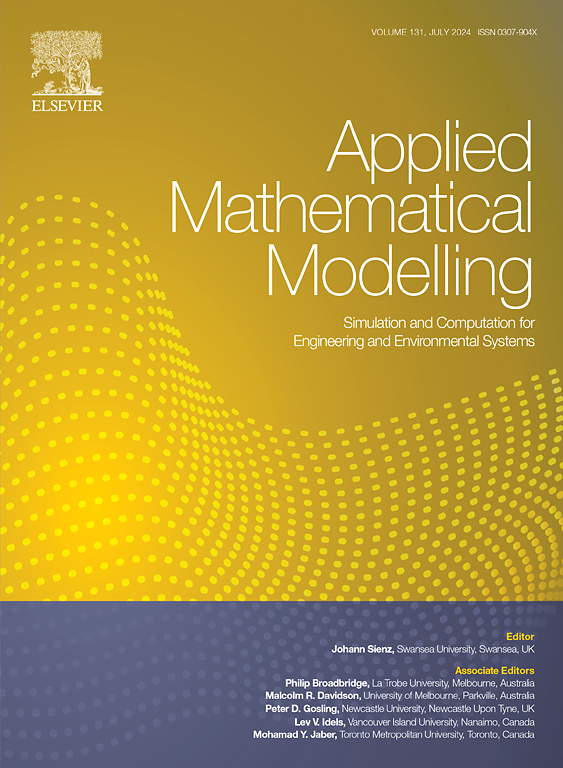分析随时间变化的岩石-混凝土相互作用:非圆形隧道的解决方案
IF 4.4
2区 工程技术
Q1 ENGINEERING, MULTIDISCIPLINARY
引用次数: 0
摘要
许多研究人员已经探索了衬砌隧道中岩石-混凝土相互作用的复杂时间依赖行为。然而,对于非圆形隧道构型,尚未提出解析解。在非圆形隧道中,沿隧道边界存在不同的曲率,导致衬砌和周围质量的应力和应变分量随时间的变化而变化。随着时间的推移,应力应变评估的准确性显著下降,特别是在高曲率边界处,即使在数值模型中使用细网格尺寸。为了解决这些问题,引入了一种新的平面应变时变解析解,用于评估受非静水原位应力作用的衬砌非圆形隧道周围的诱发应力和应变场。利用Muskhelishvili的复变方法和保角映射函数,得到一个一阶线性微分方程组。该方法通过COMSOL有限元软件进行了验证,与软件相比,大大减少了应力评估误差和时间消耗。最后,对Burgers模型参数进行了敏感性分析,揭示了隧道周围应力在短期和长期的不同影响。值得注意的是,该解适用于任何形状的隧道,并与岩体的各种线性粘弹性本构模型相兼容。本文章由计算机程序翻译,如有差异,请以英文原文为准。
Analyzing time-dependent rock-concrete interaction: A solution for non-circular tunnels
Many researchers have explored the complex time-dependent behavior of rock-concrete interaction in lined tunnels. However, for non-circular tunnel configurations, no analytical solution has been proposed yet. The presence of varying curvature along tunnel boundaries in non-circular tunnels leads to diverse effects on stress and strain components in both the lining and surrounding mass over time. As time progresses, the accuracy of stress and strain assessment significantly decreases, especially at boundaries with high curvature, even when fine grid mesh sizes are used in numerical models. To address these challenges, a novel time-dependent analytical solution in plane strain is introduced for evaluating induced stress and strain fields around a lined non-circular tunnel subjected to non-hydrostatic in situ stress. The solution, developed using the complex variable method by Muskhelishvili and conformal mapping functions, results in a system of first-order linear differential equations. This approach was validated using COMSOL finite element software, demonstrating a substantial reduction in stress evaluation errors and time consumed compared to the software. Finally, a sensitivity analysis on Burgers model parameters performed, which revealed different effects on stress induced around tunnels in short and long-term. Notably, this solution is applicable to tunnels of any shape and compatible with various linear viscoelastic constitutive models for rock masses.
求助全文
通过发布文献求助,成功后即可免费获取论文全文。
去求助
来源期刊

Applied Mathematical Modelling
数学-工程:综合
CiteScore
9.80
自引率
8.00%
发文量
508
审稿时长
43 days
期刊介绍:
Applied Mathematical Modelling focuses on research related to the mathematical modelling of engineering and environmental processes, manufacturing, and industrial systems. A significant emerging area of research activity involves multiphysics processes, and contributions in this area are particularly encouraged.
This influential publication covers a wide spectrum of subjects including heat transfer, fluid mechanics, CFD, and transport phenomena; solid mechanics and mechanics of metals; electromagnets and MHD; reliability modelling and system optimization; finite volume, finite element, and boundary element procedures; modelling of inventory, industrial, manufacturing and logistics systems for viable decision making; civil engineering systems and structures; mineral and energy resources; relevant software engineering issues associated with CAD and CAE; and materials and metallurgical engineering.
Applied Mathematical Modelling is primarily interested in papers developing increased insights into real-world problems through novel mathematical modelling, novel applications or a combination of these. Papers employing existing numerical techniques must demonstrate sufficient novelty in the solution of practical problems. Papers on fuzzy logic in decision-making or purely financial mathematics are normally not considered. Research on fractional differential equations, bifurcation, and numerical methods needs to include practical examples. Population dynamics must solve realistic scenarios. Papers in the area of logistics and business modelling should demonstrate meaningful managerial insight. Submissions with no real-world application will not be considered.
 求助内容:
求助内容: 应助结果提醒方式:
应助结果提醒方式:


